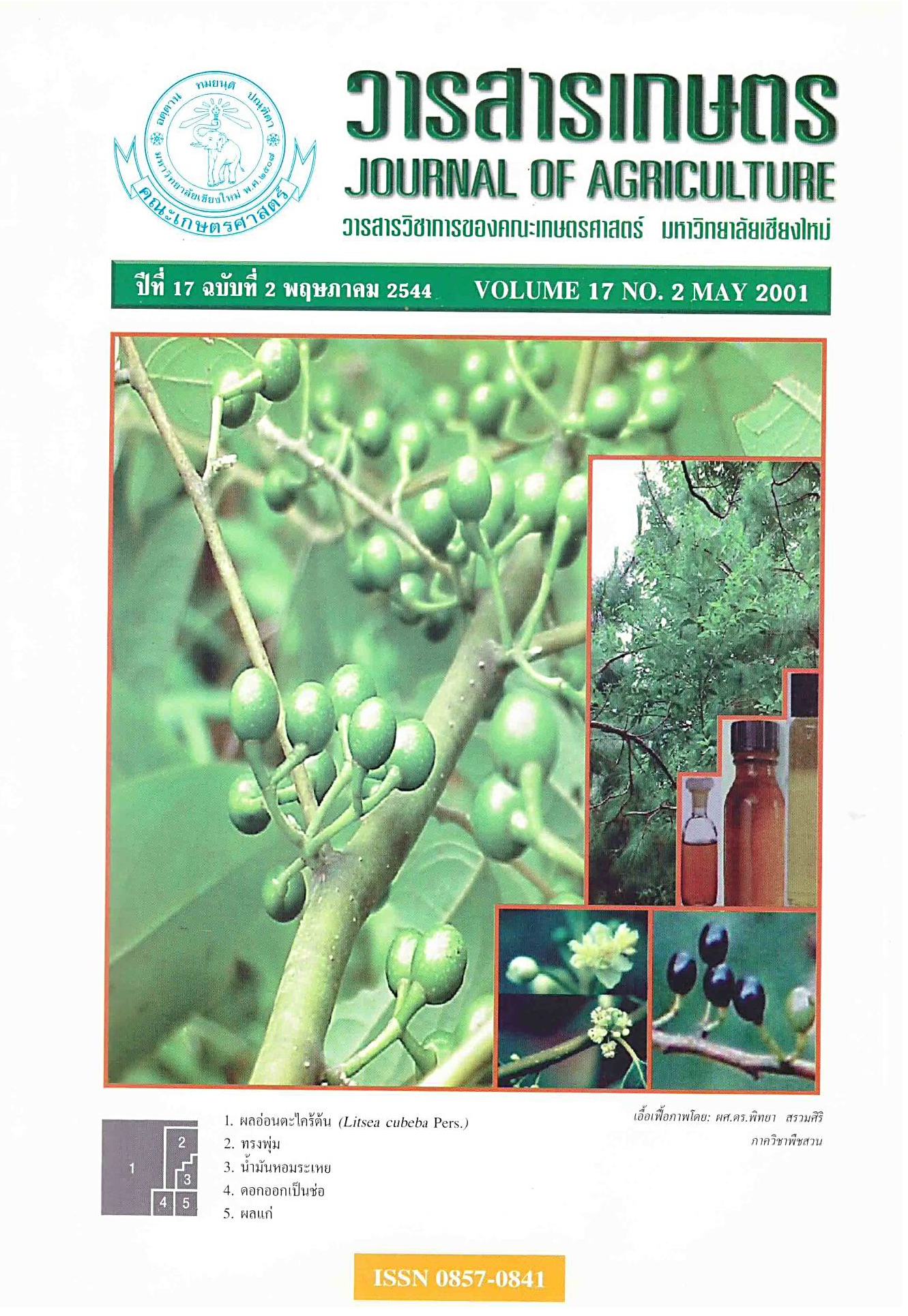การพัฒนาพ่อแม่พันธุ์ลูกผสมที่หนึ่งของพริกเผ็ด
Main Article Content
บทคัดย่อ
จากการรวบรวมพันธุ์พริกในจังหวัดเชียงใหม่และได้รับจากมหาวิทยาลัยเกษตรศาสตร์ นำมาปลูกและประเมินพันธุ์ได้สายพันธุ์ที่เหมาะเป็นสายพันธุ์พ่อ 3 สายพันธุ์ ได้แก่ 1-3-7 3-3-7 และ 4-3-7 มีลักษณะผลยาวความเผ็ดปานกลางเกสรเพศผู้ไม่เป็นหมันและให้ผลผลิตสูง จากการผสมกลับเพื่อปรับปรุงความเผ็ดของสายพันธุ์แม่ ซึ่งมีเกสรเพศผู้เป็นหมัน 2 ครั้งทำให้ได้สายพันธุ์แม่ที่มีปริมาณสารแคปไซซินเพิ่มขึ้น 3 สายพันธุ์ ได้แก่ 2735BC2#14 2735BC2#16 และ 2740BC2#10 นำสายพันธุ์แม่มาผสมตัวเองเพื่อคัดเลือกต้นที่มีเกสรเพศผู้ฝ่อจีโนไทป์ Sms/ms เพื่อใช้เป็นต้นแม่ เมื่อผสมข้ามสายพันธุ์พ่อแม่โดยวิธีผลิตลูกผสมชั่วที่ 1 (F1hybrid) ได้ลูกผสมชั่วที่ 1 9 คู่ผสม เมื่อนำมาปลูกเปรียบเทียบกับสายพันธุ์พ่อ และสายพันธุ์การค้า 3 สายพันธุ์ คือ พริกหนุ่มจอมทอง 2 พริกหนุ่มเขียว และพริกหนุ่มสันป่าตอง พบว่าพริกลูกผสมส่วนใหญ่ให้ผลผลิตสูงกว่าสายพันธุ์พ่อ และสายพันธุ์การค้า พริกลูกผสมให้ผลผลิต 20.04 ถึง 38.43 ตันต่อเฮกแตร์ สายพันธุ์พ่อให้ผลผลิต 19.55 ถึง 35.12 ตันต่อเฮกแตร์ ลูกผสมชั่วที่ 1 2740BC2#10x1-3-7 ให้ผลผลิตเฉลี่ยสูงที่สุด 38.43 ตันต่อเฮกแตร์ มีความดีเด่นของลูกผสม 5.20 เปอร์เซ็นต์ ส่วนลูกผสมชั่วที่ 1 ที่มีเปอร์เซ็นต์ความดีเด่นของลูกผสม ในด้านผลผลิตสูงที่สุด คือ ลูกผสมชั่วที่ 1 2740BC2#10 x 3-3-7 มีเปอร์เซ็นต์ความดีเด่นของลูกผสม 38.66 เปอร์เซ็นต์ ให้ผลผลิต 34.40 ตันต่อเฮกแตร์ ซึ่งลูกผสมชั่วที่ 1 2740BC2#10 x 1-3-7 มีความแตกต่างกันทางสถิติอย่างมีนัยสำคัญกับพริกหนุ่มจอมทอง 2 ที่ให้ผลผลิต 34.32 ตันต่อเฮกแตร์ แต่ลูกผสมชั่วที่ 1 2740BC2# 10 x 3-3-7 ไม่มีความแตกต่างกันทางสถิติกับพริกหนุ่มจอมทอง 2
การศึกษาความเผ็ดของพริกทั้ง 15 สายพันธุ์ ด้วยวิธีการวัดค่าการดูดกลืนแสงที่ความเข้มแสง 750 นาโนเมตร พบว่า พริกสายพันธุ์ 1-3-7 มีปริมาณสารแคปไซซินต่อน้ำหนักผล 1 กรัม สูงที่สุด 9,310 scoville unit แต่เมื่อทดสอบโดยคนชิมให้ผลต่างกัน โดยที่พริกลูกผสมชั่วที่ 1 2735BC2#16 x 3-3-7 มีค่าเฉลี่ยความเผ็ดสูงที่สุด ลูกผสมที่มีเปอร์เซ็นต์ความดีเด่นของลูกผสมด้านความเผ็ดสูงที่สุด ได้แก่ ลูกผสมชั่วที่ 1 2740BC2#10 x 3-3-7 มีเปอร์เซ็นต์ความดีเด่นของลูกผสมด้านความเผ็ด 364.76 เปอร์เซ็นต์ มีปริมาณสารแคปไซซินเฉลี่ยต่อน้ำหนักผล 1 กรัม 4,880 scoville unit และเมื่อนำปริมาณสารแคปไซซินของลูกผสมทั้งหมดมาเปรียบเทียบกับพันธุ์การค้า 3 สายพันธุ์ ได้แก่ พริกหนุ่มจอมทอง 2 พริกหนุ่มเขียว และพริกหนุ่มสันป่าตอง พบว่ามีปริมาณสารแคปไซซินมากกว่าสายพันธุ์การค้าทั้ง 3 สายพันธุ์ ซึ่งมีปริมาณสารแคปไซซินเฉลี่ยต่อน้ำหนักผล 1 กรัม 3,214 ถึง 5,363 scoville unit
Article Details
เอกสารอ้างอิง
Ahmed, N., J. Singh and K. Bajaj. 1983. Genetics of capsaicin content in Chili pepper (Capsicum annuum L.). Plant Breeding Abstracts 66(6):482.
Bosland, P.W.1996.Capsicum: Innovation use of an ancient Crop.p.479-478.In J. Janic (eds.) Progress in New Crop. ASHS Press. Arilington.
Ferrari, V., G. Celani and S. Porcelli. 1988. Research methodology on the pungency of chili peppers (Capsicum annuum L.). Sementi Elette. 6(34):9-15.
Jiang, J.Z., D.H. Wang, Z.Y. Wang and Y.S. Han. 1987. A study on the genetic parameters of the capsaicin content of pepper fruit. Scientia Agricultura Sinica. 20(6):39-43.
Hoffman, P.G., M. Lego and W. Galetto. 1983. Separation and quantitation of red pepper major heat principles by reverse-phase high pressure liquid chromatography of Ag. and food chem. 31:1326-1330.
Margaret, D.C., L.M. Wasmund and P.W. Bosland. 1995. Improved method for quantifying capsaicinoids in Capsicum using high performance liquid chromatography. Hort Sci. 30(1):137-139.
Matin, J. and J.H. Grawford. 1951. Several type of sterility in Capsicum frutescens. J. Amer. Soc. Hort Sci. 57: 335-338.
Novak, F., J. Betlach and Dubovsky. 1971. Cytoplasmic male sterility in sweet pepper (Capsicum annuum L.). phenotype and inheritance of male sterile character. Z. Pflanzenzucht.65: 129-140.
Perterson, P.A. 1958. Cytoplasmically inherited male sterility in capsicum. The American Naturalist. 92: 111-119.
Thomas, V., A. Schreiber and C. Weisskope. 1998. Simple method for quantitation of capsaiciniods in peppers using capillary gas chromatography. J. Amer. Soc. Hort Sci y. 46(7): 2655-2663.
Wisut, C. 1999. Situation of vegetable seed production in Thailand. Paper presented at “The Training course for vegetable production extension” held at Kaen Inn Hotel, Khon Kaen, Thailand, March 22-26, 1999. Department of Agriculture Extension, Ministry of Agriculture and Cooperation. Bangkok, Thailand.
Yayeh, Z. and P. Bosland. 2000. Evaluation of genotype environment and genotype by environment interaction for capsaicinoids in Capsicun annuum L. Euphytica. 111-185.
Terry B. and S.C. Shich. 2000. Chili pepper in Asia. Capsicum an Eggplant Newsletter. 19: 38-41.


